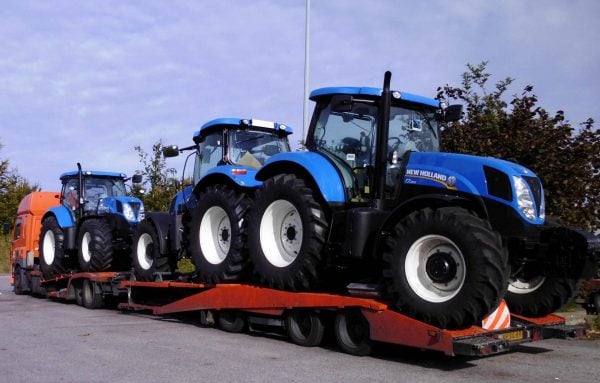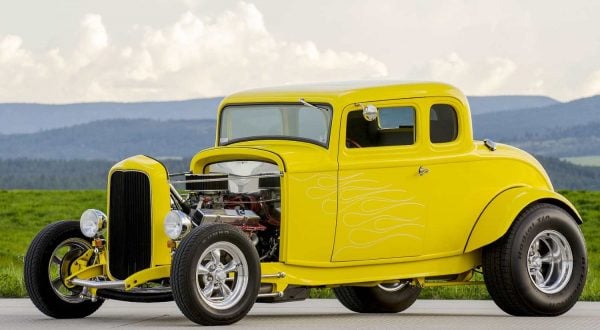Vehicle tyres have three measurements which are expressed like this: 225/45R17
- The first measurement, e.g. 225, is the width of the tyre in millimeters.
- The second measurement is the sidewall height as a percentage to the overall width (also called the aspect ratio); in this case, it is 45% of 225mm
- The third measurement is the diameter of the wheel rim (i.e. the internal diameter of the tyre) in inches, in this case, 17 inches.
It can be confusing for people that the width is metric (millimeters) while the rim size is imperial (inches).
Given the above specifications, it means there are three ways in which a tyre’s size can differ.
Width
Many vehicles, but primarily rear-wheel-drive sports cars, have a narrower width tyre at the front than the back. There are few cars that had such a marked difference in wheel sizes as the 1978 Lamborghini Countach which sported 205/50R15 on the front and enormous 345/35R15 on the back. This also meant that the overall diameter of the front and rear wheels was possibly different, too, by about 17mm (35% of 345 vs 50% of 205). The sidewall aspect is rounded to the nearest 5 so we don’t actually know what the real diameter is.
Having wide rear wheels is for the reasons of traction and the ‘look’. When a rear-wheel-drive car has a lot of power, it can cause wheelspin easily which is why wider rear tyres can give better traction. However, wide tyres tend to follow grooves and ridges in the road more easily (‘tramlining’), they require more steering effort, create more rolling resistance (effort required to start them turning and to keep them turning) and make it more difficult to get good suspension performance through them being heavier. For the front wheels, having wider tyres means having bigger wheel wells to accommodate them turning and, beyond a certain width, there is not much extra grip when turning.
While it’s fine to put narrower tyres on the front and wider on the back, it’s pointless to put wider tyres on just one side of the car. This would change the weight balance and would mean one side of the vehicle would grip differently to the road when braking. It would change the cornering dynamic, too.
Rim diameter
Some vehicles have wheels of a different diameter. While the Lamborghini mentioned above had the same rim diameter (15 inches), obvious examples of different rim sizes can be found in agricultural vehicles like tractors. It’s also fairly common on smaller rigid trucks where the rear wheels are a small diameter, and on low-boy trailers where the trailer wheels are smaller so that the trailer deck can be lower to the ground.

It’s very uncommon for cars to have rims of different sizes. The Chrysler Prowler did it with 17-inch wheels on the front and 20-inch wheels on the rear to mimic hot rods.

Again, the wheels are the same size at the rear and the same size at the front, but you couldn’t mix the two otherwise the car would want to steer in one direction, something that is done in dirt track racing.

Sidewall aspect ratio
As the overall diameter of the wheel is affected by the sidewall ratio it’s important to match them from side-to-side.
What happens if wheels are different sizes
In a front- or rear-wheel-drive vehicle, as long as both rear wheels are the same and both front wheels are the same and the suspension geometry is set up to accommodate this, the vehicle will operate fine.
If the vehicle is four-wheel-drive and has different sized wheels front and back, this can cause problems with the centre differential unless it’s designed for that.
If you fit a space saver wheel, which will be a smaller diameter than the standard wheel, you must keep your speed under 80km/h and only drive the minimum distance necessary to get the tyre replaced otherwise you can cause damage to your differential.
When you accelerate, the vehicle will pull towards the side of the smaller wheel.
If you have electronic stability control or traction control then it is likely to activate more frequently as the difference in wheel speed will confuse the sensors, making it think you are skidding.
There’s also the obvious problem of trucks having to carry two different sizes of spare tyre; cars can usually use a space saver wheel.
When one tyre needs changing because it’s worn out, should you also change the one on the other side?
Your tyres should experience a roughly even amount of wear. If this isn’t happening, then perhaps the pressure is low on one side or there is a misalignment. It’s always better to get both tyres replaced at the same time because as your tyres wear, the diameter changes. If you get a puncture on one side that can’t be replaced and your other tyre is fairly new, it is usually not worth changing the other tyre, but if both tyres are fairly worn there will be a larger discrepancy in the diameters and you should change both.
Can you fit wider tyres than the ones that came with your vehicle?
Check with a tyre shop because some rims will easily accommodate a tyre that is 10-20mm wider, but others won’t. Bear in mind that the wider your wheels are, the more fuel you will use because the rolling resistance is increased. Wider tyres are typically more expensive to purchase because they contain more rubber, are heavy and bigger to transport and are produced in lower quantities which means fewer economies of scale in the production process.
So, it might be fine to go from a 205/50R16 to an equivalent tyre (e.g. 225/45R17) but if the diameter of your tyre changes much, you will need to recalibrate your speedometer otherwise it will be inaccurate and this will also affect the overall odometer reading of your vehicle.
How much wider can you go with your tyres?
20mm is usually within the tolerance of the vehicle. More than that, and you might find that the tyre rubs on the guards or wheel wells, particularly on bumpy ground or when you are turning tight corners.
Can you fit tyres with a bigger or smaller diameter than the ones that came with your vehicle?
There’s usually room to go a fraction bigger, unless you have lowered suspension. If you change the overall circumference of the tyre by going bigger or smaller, it affects your odometer:
Smaller tyres means you put more kilometers on your odometer because the wheels are turning more per kilometer, and vice versa for larger tyres.
If this difference is too much, it has the potential to affect the anti-lock brakes and the electronic stability control.
Wheels that are much heavier because they are bigger will affect the unsprung mass of the vehicle, i.e. how the suspension reacts in relation to the wheels, and this could affect the handling.
Larger wheels require more power to get them turning; this will slow down acceleration. Smaller wheels are easier to turn, so this will improve acceleration.
Smaller tyres will wear out more quickly than larger tyres because they are rotating more frequently and will also generate slightly more heat. If your tyres are rotating 5% more per kilometer, that’s 5% more wear per kilometer compared to a larger tyre!

